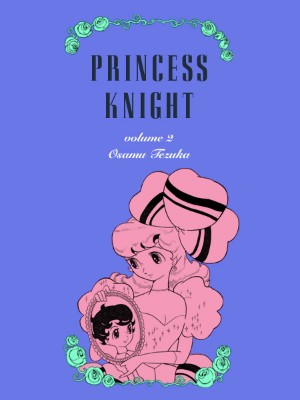By Osamu Tezuka. Released in Japan as “Ribon no Kishi” by Kodansha, serialized in the magazine Nakayoshi. Released in North America by Vertical.
This second volume of Princess Knight continues right where the previous one left off, with Sapphire going from one threat to another. The threats get worse this time around, however. First her girl heart is successfully stolen, leaving Sapphire as a boy (albeit a very shapely boy). And later on, when that heart is stolen as well, Sapphire falls into a coma. Can Tink manage to sort everything out at last? Can Sapphire ever find true happiness? Well, yes, but not before the end of the book. This is high adventure romance, after all.
(I’m not certain why the online images of this book feature different colors on the cover than the actual volumes themselves. Pretend that the picture you see above is far less blue.)
Much as I love Sapphire, and she gets some great things to do here, she does spend a fair amount of time in this volume reacting to others. So I spent a fair amount of time watching her reactions, and was struck by how well Tezuka can convey emotions with minimal effort. Sapphire’s face on the bottom of page 16, when confronted by Prince Franz, is “why must my love hate me”, “why is this happening to me”, and “oh my god, why does he not GET IT” all in one. Without her honest love, worry and despair throughout these pages, the book would suffer greatly.
It has to be said, there is a certain ‘I am writing from week to week with no real thought in mind’ feel to this book. The main antagonist from Volume One, the witch, is dispatched halfway through this book, which seems early to me, and is promptly replaced by the Goddess Venus, who can also do bad things to Sapphire via supernatural means. Likewise, the witch’s spunky and likeable daughter, Hecate (who also dies, which is a shame) is replaced by the spunky yet likeable Friebe, and for a moment I thought there was some reincarnation thing going on, but no. You aren’t really reading Princess Knight for realism, so you have to accept there is a certain ludicrousness here in terms of throwing obstacles in front of the heroine. (And what was with that sudden repentance and suicide of one of the main villains? Sheesh.)
Speaking of Hecate and Friebe, the book is also quite good at presenting some strong and likeable women. Hecate is tied to her mother by more than just blood, and yet is determined to live her own life, rather than one chosen for her by her mother – even if she does grow to like Prince Franz. Likewise Friebe may be the classic ‘searching for a strong man to marry me’ type knight, but this does not diminish her swordfighting skills in any way, and she ends the book still in armor and with sword (as opposed to Sapphire, it must be said). Then there’s the battle at the castle between the male army and their wives (who have given Sapphire sanctuary). It’s filled with amazingly shallow stereotypes, but its heart is in the right place, and it does mock the classic ‘only men are fit to rule’ idea seen in a number of fairy tales.
The thing that summed up the book in my mind was a line of dialogue said by Friebe’s brother Oolong (who is a wonderful character in his own right – after so many royal idiots, it’s a pleasure to see one who plays the role for all it’s worth). When Friebe cries on his shoulder and admits she can’t marry Sapphire as Sapphire is a woman, he laughs and notes that “you can find women as manly as any man in every country”. He’s gently mocking the fact that she zeroed in on Sapphire as her choice, but it also allows us to be more comfortable in Sapphire’s ending, where she finds the Prince and presumably lives happily ever after. Sapphire may go on to be a feminine queen, but there are strong, capable women like her in every kingdom. She is not a rare and precious snowflake. And that’s a good thing.
I’m not sure that Twin Knight (the sequel to the original Princess Knight that ran in Nakayoshi in the late 1950s) is likely to be licensed anytime soon, so this may be the last we see of Sapphire for a while. I’m very happy we got her story, though, and I hope that in the future Vertical can publish more of Tezuka’s ‘children’s’ works, in addition to his gritty adult titles.


Pingback: Looking forward to the holidays… and beyond! « MangaBlog